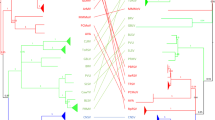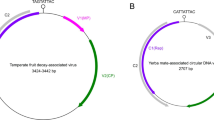Abstract
This study focuses on the phylogenetic analysis of previously unclassified tombus-like viruses, which are characterized by the presence of homologs of the suppressor protein p19. The primary objectives of this research were to investigate the evolutionary relationships among these viruses and to explore the impact of suppressor proteins and recombination events on their evolution. A dataset comprising 94 viral sequences was analyzed to achieve these goals. The phylogenetic analysis revealed the presence of two distinct clusters within the tombus-like virus group. One cluster consisted of viruses that encoded p19-like RNA suppressors, while the other cluster comprised viruses encoding p14-like suppressors. Based on these findings, we propose the classification of PGT-pt108 as an isolate of carnation Italian ringspot virus (CIRV), and both Tombusviridae sp. s48-k141_139792 and Tombusviridae sp. s51-k141_185213 as isolates of tomato bushy stunt virus (TBSV). Furthermore, this study suggests the establishment of two new genera within the family Tombusviridae, based on the observed divergence and distinct characteristics of these tombus-like viruses. Through the analysis of recombination events, we provide insights into the interspecies movement of CIRV, which is reflected in its phylogenetic positioning. This research contributes to our understanding of the evolutionary dynamics and classification of tombus-like viruses, shedding light on the role of suppressor proteins and recombination events in their evolution and interspecies transmission.












Similar content being viewed by others
Data availability
Data sharing is not applicable to this article, as no datasets were generated during the current study.
References
White KA (2021) Tombusvirus-like viruses (Tombusviridae). In: Bamford DH, Zuckerman M (eds) Encyclopedia of virology, 4th edn. Academic Press, Oxford, pp 778–787. https://doi.org/10.1016/B978-0-12-809633-8.21260-0
King AMQ, Adams MJ, Carstens EB, Lefkowitz EJ (2012) Family—Tombusviridae. Virus taxonomy. Elsevier, San Diego, pp 1111–1138. https://doi.org/10.1016/B978-0-12-384684-6.00096-3
Koenig R, Lesemann D-E, Pfeilstetter E (2009) New isolates of carnation Italian ringspot virus differ from the original one by having replication-associated proteins with a typical tombusvirus-like N-terminus and by inducing peroxisome-rather than mitochondrion-derived multivesicular bodies. Arch Virol 154:1695–1698. https://doi.org/10.1007/s00705-009-0491-9
Koenig R, Verhoeven JTJ, Fribourg CE, Pfeilstetter E, Lesemann DE (2004) Evaluation of various species demarcation criteria in attempts to classify ten new tombusvirus isolates. Arch Virol 149:1733–1744. https://doi.org/10.1007/s00705-004-0331-x
Clark K, Karsch-Mizrachi I, Lipman DJ, Ostell J, Sayers EW (2016) GenBank. Nucleic Acids Res 44:67–72. https://doi.org/10.1093/nar/gkv1276
Tamura K, Stecher G, Kumar S (2021) MEGA11: molecular evolutionary genetics analysis version. Mol Biol Evol 38:3022–3027. https://doi.org/10.1093/molbev/msab120
Muhire BM, Varsani A, Martin DP (2014) SDT: a virus classification tool based on pairwise sequence alignment and identity calculation. PLoS ONE 9:e108277. https://doi.org/10.1371/journal.pone.0108277
Madeira F, Pearce M, Tivey ARN, Basutkar P, Lee J, Edbali O, Madhusoodanan N, Kolesnikov A, Lopez R (2022) Search and sequence analysis tools services from EMBL-EBI in 2022. Nucleic Acids Res 50:276–279. https://doi.org/10.1093/nar/gkac240
Minh BQ, Schmidt HA, Chernomor O, Schrempf D, Woodhams MD, von Haeseler A, Lanfear R (2020) IQ-TREE 2: new models and efficient methods for phylogenetic inference in the genomic era. Mol Biol Evol 37:1530–1534. https://doi.org/10.1093/molbev/msaa015
Kalyaanamoorthy S, Minh BQ, Wong TKF, von Haeseler A, Jermiin LS (2017) ModelFinder: fast model selection for accurate phylogenetic estimates. Nat Methods 14:587–589. https://doi.org/10.1038/nmeth.4285
Hoang DT, Chernomor O, von Haeseler A, Minh BQ, Vinh LS (2018) UFBoot2: improving the ultrafast bootstrap approximation. Mol Biol Evol 35:518–522. https://doi.org/10.1093/molbev/msx281
Bianchini G, Sánchez-Baracaldo P (2023) TreeViewer Version2.1.0. https://doi.org/10.5281/zenodo.7768344
Martin DP, Varsani A, Roumagnac P, Botha G, Maslamoney S, Schwab T, Kelz Z, Kumar V, Murrell B (2021) RDP5: a computer program for analyzing recombination in, and removing signals of recombination from, nucleotide sequence datasets. Virus Evol 7:veaa087. https://doi.org/10.1093/ve/veaa087
Martin D, Rybicki E (2000) RDP: detection of recombination amongst aligned sequences. Bioinformatics 16:562–563. https://doi.org/10.1093/bioinformatics/16.6.562
Padidam M, Sawyer S, Fauquet CM (1999) Possible emergence of new geminiviruses by frequent recombination. Virology 265:218–225. https://doi.org/10.1006/viro.1999.0056
Martin DP, Posada D, Crandall KA, Williamson C (2005) A modified bootscan algorithm for automated identification of recombinant sequences and recombination breakpoints. AIDS Res Hum Retroviruses 21:98–102. https://doi.org/10.1089/aid.2005.21.98
Smith JM (1992) Analyzing the mosaic structure of genes. J Mol Evol 34:126–129. https://doi.org/10.1007/BF00182389
Posada D, Crandall KA (2001) Evaluation of methods for detecting recombination from DNA sequences: computer simulations. Proc Natl Acad Sci 98:13757–13762. https://doi.org/10.1073/pnas.241370698
Gibbs MJ, Armstrong JS, Gibbs AJ (2000) Sister-scanning: a Monte Carlo procedure for assessing signals in recombinant sequences. Bioinformatics 16:573–582. https://doi.org/10.1093/bioinformatics/16.7.573
Mirdita M, Schütze K, Moriwaki Y, Heo L, Ovchinnikov S, Steinegger M (2022) ColabFold: making protein folding accessible to all. Nat Methods 19:679–682. https://doi.org/10.1038/s41592-022-01488-1
Schrödinger L, DeLano W (2020) PyMOL. http://www.pymol.org/pymol
Danielson DC, Pezacki JP (2013) Studying the RNA silencing pathway with the p19 protein. FEBS Lett 587:1198–1205. https://doi.org/10.1016/j.febslet.2013.01.036
Duan C-G, Fang Y-Y, Zhou B-J, Zhao J-H, Hou W-N, Zhu H, Ding S-W, Guo H-S (2012) Suppression of Arabidopsis ARGONAUTE1-mediated slicing, transgene-induced RNA silencing, and DNA methylation by distinct domains of the cucumber mosaic virus 2b protein. Plant Cell 24:259–274. https://doi.org/10.1105/tpc.111.092718
Xiong R, Wu J, Zhou Y, Zhou X (2009) Characterization and subcellular localization of an RNA silencing suppressor encoded by Rice stripe tenuivirus. Virology 387:29–40. https://doi.org/10.1016/j.virol.2009.01.045
Qiu W, Park J-W, Scholthof HB (2002) Tombusvirus P19-mediated suppression of virus-induced gene silencing is controlled by genetic and dosage features that influence pathogenicity. MPMI 15:269–280. https://doi.org/10.1094/MPMI.2002.15.3.269
Omarov R, Sparks K, Smith L, Zindovic J, Scholthof HB (2006) Biological relevance of a stable biochemical interaction between the tombusvirus-encoded P19 and short interfering RNAs. J Virol 80:3000–3008. https://doi.org/10.1128/JVI.80.6.3000-3008.2006
Vargason JM, Szittya G, Burgyán J, Hall TMT (2003) Size selective recognition of siRNA by an RNA silencing suppressor. Cell 115:799–811. https://doi.org/10.1016/S0092-8674(03)00984-X
Chu M, Desvoyes B, Turina M, Noad R, Scholthof HB (2000) Genetic dissection of tomato bushy stunt virus p19-protein-mediated host-dependent symptom induction and systemic invasion. Virology 266:79–87. https://doi.org/10.1006/viro.1999.0071
Mérai Z, Kerényi Z, Molnár A, Barta E, Válóczi A, Bisztray G, Havelda Z, Burgyán J, Silhavy D (2005) Aureusvirus P14 is an efficient RNA silencing suppressor that binds double-stranded RNAs without size specificity. J Virol 79:7217–7226. https://doi.org/10.1128/JVI.79.11.7217-7226.2005
Zhao F, Baek D, Igori D, Bae JY, Kim S-M, Ra J-E, Do Park K, Lee BC, Moon JS (2017) Complete genome sequence of rice virus A, a new member of the family Tombusviridae. Arch Virol 162:3247–3250. https://doi.org/10.1007/s00705-017-3472-4
Acknowledgements
Dedicating this work to the memory of our esteemed teacher and professor, Rustem Omarov, we would like to express our gratitude and respect for the person who played a significant role in our education and development.
Funding
This research was funded by the Science Committee of the Ministry of Education and Science of the Republic of Kazakhstan (Grant no. AP09258746).
Author information
Authors and Affiliations
Contributions
All authors contributed to the conception and design of this study. All authors have read and approved the final manuscript.
Corresponding author
Ethics declarations
Conflict of interest
The authors declare that they have no competing interests.
Additional information
Handling Editor: Massimo Turina.
Publisher's Note
Springer Nature remains neutral with regard to jurisdictional claims in published maps and institutional affiliations.
Supplementary Information
Below is the link to the electronic supplementary material.
Rights and permissions
Springer Nature or its licensor (e.g. a society or other partner) holds exclusive rights to this article under a publishing agreement with the author(s) or other rightsholder(s); author self-archiving of the accepted manuscript version of this article is solely governed by the terms of such publishing agreement and applicable law.
About this article
Cite this article
Madirov, A., Yermukhambetova, R. & Masalimov, Z. Exploring the diversity and evolution of tombus-like viruses: phylogenetic analysis, recombination events, and suppressor protein homologs. Arch Virol 168, 287 (2023). https://doi.org/10.1007/s00705-023-05909-0
Received:
Accepted:
Published:
DOI: https://doi.org/10.1007/s00705-023-05909-0




